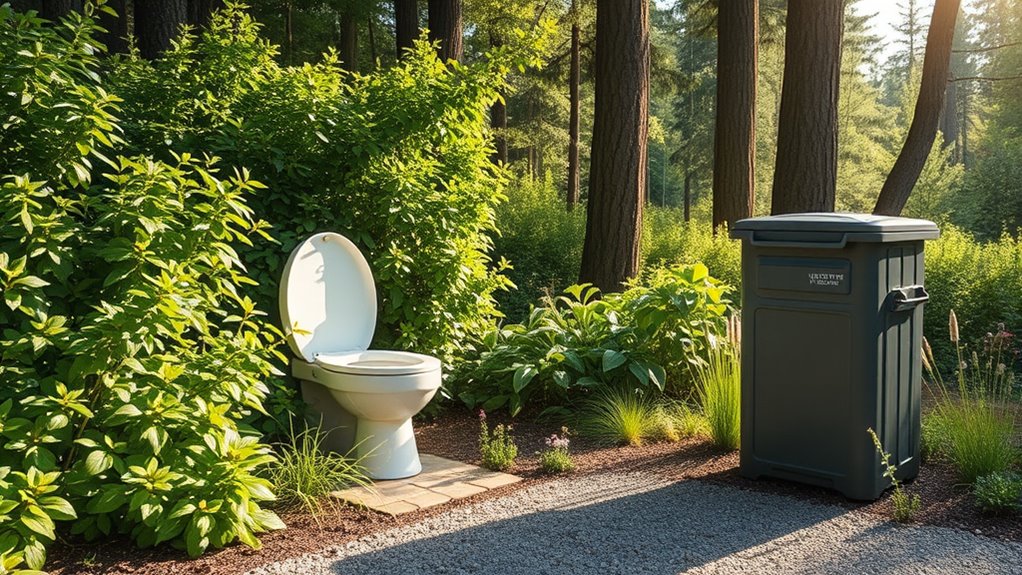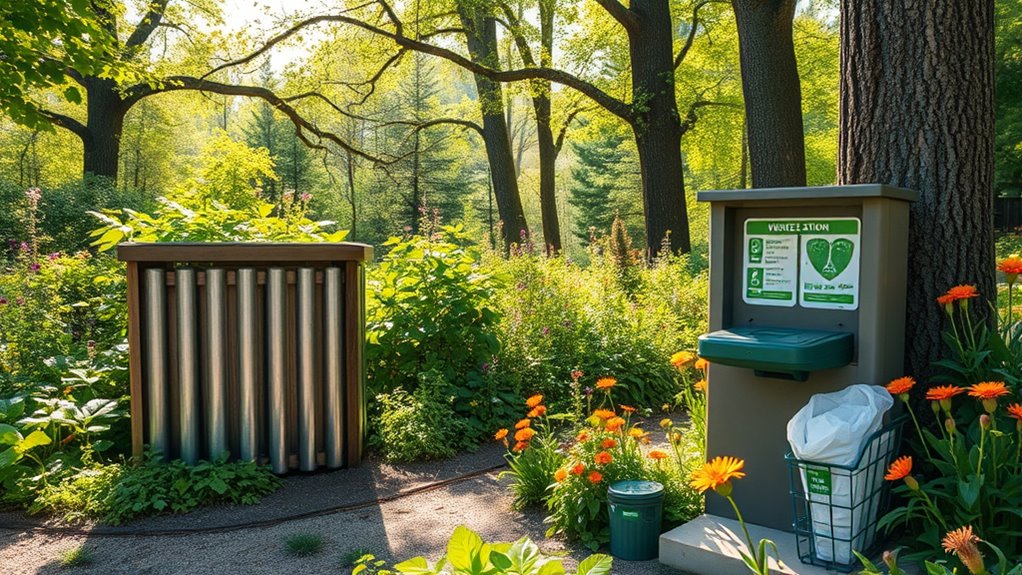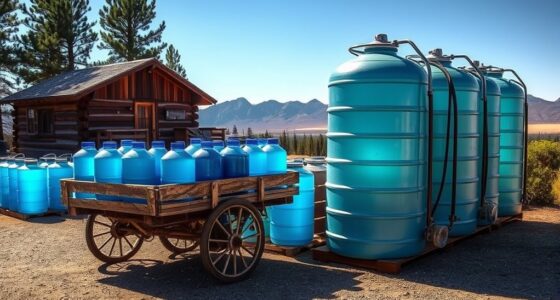To guarantee wildlife-safe sanitation outdoors, you should always carry out your human waste, digging a cathole at least six inches deep and away from water sources, then covering it thoroughly. Store trash in sealed, wildlife-proof containers and keep it away from campsites. Clean cooking gear to reduce odors and avoid cooking near your site. Proper waste and scent management prevent animals from being attracted and help protect the environment—learn how to refine these practices for safer adventures.
Key Takeaways
- Properly dispose of human waste in a cathole at least six inches deep, far from water sources and campsites.
- Use sealed, wildlife-proof containers for trash and food waste, storing them away from campsites and water.
- Clean utensils thoroughly and avoid cooking or eating near the campsite to minimize scent trails.
- Cover all waste thoroughly with soil and seal trash to reduce odor emissions attracting wildlife.
- Understand animal behaviors to adopt sanitation practices that prevent habituation and promote ecological balance.

Ensuring sanitation practices that protect wildlife is essential as human activities increasingly intersect with natural habitats. When you’re outdoors, how you handle waste can significantly impact local animals and their environment. Proper human waste disposal isn’t just about cleanliness; it’s about preventing wildlife attractants that could threaten their safety and disrupt ecological balance. Leftover food scraps, scented trash, or improperly managed waste can lure animals closer to human activity, increasing the risk of conflicts, injuries, or dependency on human sources for food. To minimize these risks, you need to be deliberate and diligent about waste management when outdoors.
First, always carry out all human waste and dispose of it properly. If there are no designated facilities, use a portable toilet or dig a cathole at least six inches deep and far from water sources, trails, and campsites. Cover the waste thoroughly with soil afterward. This practice helps prevent odor leakage, which can act as a strong wildlife attractant, drawing animals toward human activity and increasing their risk of habituation or conflict. Remember, even small traces of waste or residual scent can be enough to attract curious animals, so leave no trace and maintain a high standard of hygiene.
Managing trash is equally important. Use sealed, wildlife-proof containers for garbage and food waste, and store these containers away from campsites and water sources. Avoid leaving food scraps or scented items exposed, as these are prime attractants for wildlife seeking easy nourishment. When you leave a site, double-check that all trash is secured and removed, preventing animals from scavenging and becoming overly reliant on human leftovers. The goal is to keep natural food sources available and accessible only to wildlife that naturally depends on them, not to animals lured in by easy, human-provided treats.
Odor control plays a critical role in maintaining safe outdoor environments. Clean any cooking utensils and containers thoroughly to eliminate lingering smells that might attract animals. If possible, avoid cooking or eating near your campsite to reduce scent trails. When disposing of waste, do so in a way that minimizes odor emissions—burying waste properly and sealing trash canisters helps keep scents contained. These simple steps make a big difference in deterring wildlife from associating human presence with food, which can lead to dangerous encounters or long-term dependency. Additionally, understanding wildlife behavior and their sensitivities can help you adopt more effective sanitation practices to protect both humans and animals.
Frequently Asked Questions
How Can I Prevent Attracting Wildlife to My Sanitation Area?
To prevent attracting wildlife to your sanitation area, make sure you dispose of food scraps properly and quickly, avoiding any lingering odors. Keep the area clean and covered to reduce shelter attraction, as animals seek shelter around waste and debris. Use sealed containers for waste and remove any waste regularly. By controlling odors and shelter opportunities, you minimize the chances of wildlife coming near your sanitation site.
Are There Eco-Friendly Waste Disposal Options Suitable for Wildlife Safety?
Yes, you can use eco-friendly waste disposal options like biodegradable bags to safely contain waste, reducing wildlife attraction. Incorporate natural deodorants to control odors without chemicals that draw animals. Always dispose of waste properly in designated areas and avoid leaving residual waste outdoors. These practices help protect wildlife while maintaining an environmentally friendly sanitation routine, ensuring that your outdoor space remains safe and odor-free.
What Materials Are Best for Wildlife-Safe Composting Toilets?
You might think fancy materials are needed, but simple biodegradable options work best for wildlife-safe composting toilets. Use compost materials like sawdust, coconut coir, or straw—these natural, eco-friendly choices prevent harm to animals and break down easily. Avoid plastics or synthetic options that could be harmful or non-biodegradable. Embrace these natural materials, and you’ll create a safe, odor-free environment that benefits wildlife and your outdoor space alike.
How Often Should I Inspect Wildlife-Safe Sanitation Sites?
You should inspect your wildlife-safe sanitation sites at least once a week to ensure safety and proper functioning. An inspection schedule helps prevent wildlife disturbance by catching issues early, such as odors or waste leaks. Regular checks allow you to maintain the site effectively, reduce potential wildlife encounters, and address any problems promptly. Staying consistent with inspections keeps your sanitation practices safe for both humans and local wildlife.
Can Wildlife Interfere With Sanitation Systems, and How to Prevent It?
Wildlife can interfere with sanitation systems, causing disruption and potential health issues. To prevent wildlife intrusion, secure lids tightly, use wildlife-proof enclosures, and install fencing around your site. Regular inspections help spot signs of intrusion early. Keep waste covered and dispose of it promptly to minimize attracting animals. By taking these steps, you protect your sanitation system from wildlife disruption and maintain a safe, odor-free outdoor environment.
Conclusion
By following wildlife-safe sanitation practices outdoors, you not only protect animals but also create a cleaner environment for everyone. It’s funny how a simple habit—like properly storing waste—can prevent unexpected encounters or accidents. When you keep odors in check and waste contained, you might find yourself enjoying nature even more, unaware of how small actions make a big difference. So, next time you’re outdoors, remember: your habits could be the reason wildlife stays safe—and you do too.









